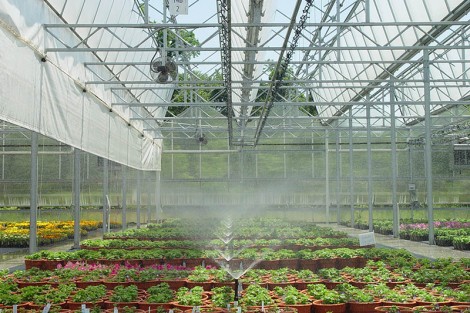
A Greenhouse Environment
Greenhouse vegetable crop production is based on controlling the environment to provide the conditions most favorable for maximum yield. A plant’s ability to grow and develop depends on the photosynthetic process. In the presence of light, the plant combines carbon dioxide and water to form sugars, which are then utilized for growth and fruit production. Optimizing the greenhouse environment is directed at optimizing the photosynthetic process in the plants, enhancing the plant’s ability to utilize light at maximum efficiency.
Photosynthesis is one of the most significant life processes; all the organic matter in living things comes about through photosynthesis. It requires certain inputs to get the desired outputs. Carbon dioxide and water are combined and modified to produce sugar. The sugars are further used to form more complex carbohydrates, oils and so on. Along with the photosynthetic process are many more processes in the plant that help ensure the plant can grow and develop using the energy from the light energy.
From the grower’s point of view, the result of photosynthesis is the production of fruit. This outcome serves to remind that the management decisions made in growing crops affect the outcome of how well the plant is able to run its photosynthetic engines to manufacture those products that are shipped to market.
Growers provide the nutrition and environment that direct the plant to optimize photosynthesis and fruit development. Crop management decisions require knowledge of how to keep the plants in balance so that yield and the productive life of the crop are maximized.
Inherent to high yielding greenhouse crop production are the concepts of plant balance and directed growth. A plant growing in the optimum environment for maximum photosynthetic efficiency may not be allocating the resulting production of sugars for maximum fruit production. Greenhouse vegetable plants respond to a number of environmental triggers, or cues, and can alter their growth habits as a result.

A Heating System
The simplest example is to consider whether the plants have a vegetative focus or a generative focus. A plant with a vegetative focus is primarily growing roots, stems and leaves, while a plant with a generative focus is concentrating on flowers and fruit production. Vegetative and generative plant growth can be thought of as two opposite ends of a continuum, the point where maximum sustained fruit production takes place is where vegetative growth is balanced with generative growth. Complete optimization of the growing environment for crop production also includes providing the correct environmental cues to direct plant growth to maintain a plant balance for profitable production.
The critical environmental parameters affecting plant growth that growers can control in the greenhouse are as follows:
- Temperature
- Relative humidity
- carbon dioxide
- nutrition
- availability of water
- growing media

Cooling & Humidification in Greenhouses
The way the environment affects plant growth is not necessarily straightforward, and the effect of one parameter is mediated by the others. The presence of the crop canopy also exerts considerable influence on the greenhouse environment. The ability of growers to provide the optimal environment for their crops improves over time, with experience. There is a conviction that environmental control of greenhouses is an art that expert growers practice to perfection. That being said, there are basic rules and environmental setpoints that beginning growers can follow as a blueprint to grow a successful crop.

Controlling algae on growing media
As the plants develop from the seedling phase to maturity, the conditions that determine the optimum environment for the crop also change. Even when the crop is into full production, modifications of the environment may be necessary to ensure maximum production is maintained. For example, the plants may start to move out-of-balance to become too vegetative or too generative. Through all stages of the crop cycle, growers must train themselves to recognize the indicators displayed by the crop to determine what adjustments in the environment are necessary, if any.
Image Credits : www.roughbros.com